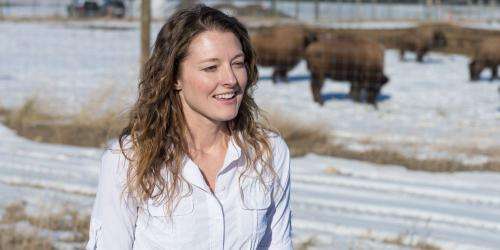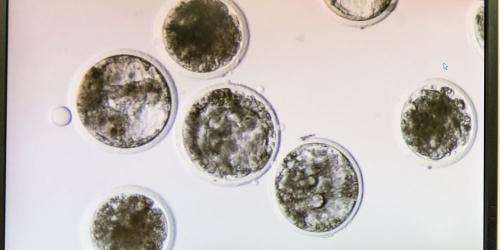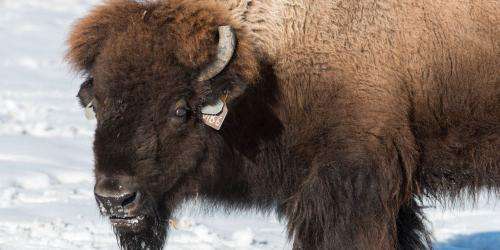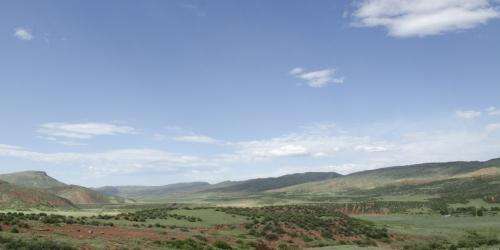Northern Colorado bison project uses high-tech breeding to halt disease and conserve an icon

A seed herd of purebred American bison – offspring of the iconic native species in Yellowstone National Park – will be reintroduced this fall to a natural area at the hinge of the Rocky Mountains and the Great Plains after an agreement is finalized this week between Colorado State University and three government agencies.
"The Yellowstone herd is so unique. It started the U.S. conservation movement in large animals," said Dr. Jack Rhyan, a veterinarian with the U.S. Department of Agriculture in Fort Collins and a partner in the reintroduction project. "It's exciting that Fort Collins is part of this really great American story. We're having a role in the story of bison conservation and restoration."
The bison release is set for Nov. 1 on 800 fenced acres at Soapstone Prairie Natural Area, owned by the city of Fort Collins, and adjacent Red Mountain Open Space, owned by Larimer County. The site is in northern Colorado, near the Wyoming border, where bison once roamed freely before they were slaughtered to near extinction in the late 1800s.
The release date itself is symbolic, coming on National Bison Day and at the start of Native American Heritage Month.
The bison in northern Colorado will be among just a handful of genetically pure herds raised privately, by American Indian tribes and by government agencies in the United States. Colorado State scientists hope that, as the herd grows, the project will provide bison to other conservation efforts.
"This bison reintroduction project has the potential to fulfill many needs and interests, and we're really pleased to contribute," said Dr. Mark Stetter, a wildlife veterinarian and dean of the CSU College of Veterinary Medicine and Biomedical Sciences.
Conservationists for years have envisioned bison reintroduction in northern Colorado. The aspiration is becoming reality with the problem-solving use of assisted reproductive technologies developed over several decades at CSU, chiefly for production livestock and high-value performance horses. Similar techniques, including in vitro fertilization and embryo transfer, are used to help people with fertility problems attain pregnancy.
In this case, the technologies – including a special washing technique to cleanse bison embryos of potentially dangerous pathogens – are being used to help conserve dynastic American bison, while also guaranteeing the animals are free from an infectious disease loathed by cattle ranchers and wildlife fans.
"We realized we have the tools to get around the disease to help the city establish a bison seed herd," said Jennifer Barfield, the reintroduction project's scientific leader, with Colorado State's Animal Reproduction and Biotechnology Laboratory.
Barfield recalled a meeting over coffee three years ago, when she and collaborators realized that assisted reproductive technologies long used in beef and dairy cattle could be applied to a different end: species conservation and, critically, disease control.

"All the pieces seemed to fall into place," said Barfield, an assistant professor trained in conservation biology and reproductive physiology. "I started with this project really excited by the science, the idea that we could use the bovine reproduction system in a different way.
"But I've developed this passion for the bison," she said. "They're so culturally important. The heritage they carry with them has been the extra motivation to make this work."
The creatures to form the Laramie Foothills Bison Conservation Herd at Soapstone Prairie Natural Area and Red Mountain Open Space are now housed on CSU's Foothills Campus. The group released will number only a dozen.
They are coveted for two characteristics: Their genetic makeup is pure American bison, according to current genetic tools, without cattle genes that are nearly always present as a result of interbreeding in the decades after bison were nearly wiped out. Even crossbred animals that look like pure bison typically carry cattle genes.
The reintroduced group, originating from animals quarantined for more than a decade, has repeatedly tested free of the devastating infectious disease bovine brucellosis. Caused by the bacterium Brucella abortus, the disease affects cattle, bison and elk. The pathogen can pass among these species when they intermingle, as when elk traipse between herds of bison and cattle in and near Yellowstone National Park. The result: spontaneous abortions that can devastate both wild and domestic herds.
Brucella abortus also can infect people, known in that case as "undulant fever" for rising and falling fever and other symptoms. Such illness has occurred in the United States when veterinarians and ranchers have unknowingly assisted infected cows with calving.
Yet problems with bovine brucellosis will be avoided with the Laramie Foothills reintroduction plan. Barfield and her team have collected semen from bison bulls housed at CSU; if any of the shaggy-coated males has tested positive for exposure to Brucella, the semen is washed in a laboratory procedure.
The bison bound for the Laramie Foothills Bison Conservation Herd were produced when females were artificially inseminated with cleaned semen, or when this process preceded embryo transfer – another high-tech step applied in this project to halt disease.

The scientific team is now using a third strategy, which allows use of eggs from even more bison and will add genetic diversity to the conservation herd. With this method, in vitro fertilization is accomplished in the laboratory by joining clean bison semen with eggs collected from purebred bison cows. Resulting embryos are incubated, tended by graduate students who act as laboratory midwives. The microscopic embryos likewise undergo rinsing to rid the bison herd of any potential brucellosis pathogen.
After a week of incubation, the embryos are bathed in cryoprotectant, which shields cellular structures, and are plunked into liquid nitrogen; they instantly freeze to a temperature colder than the moon at night. This quick freeze turns cellular structures to glass, called vitrification. It prevents damaging intracellular ice crystals that would hamper pregnancy success.
The frozen embryos – now called blastocysts – are stored and soon will be thawed and transferred to bison females. With successful implantation, the little cell clumps will develop naturally and will be born to bison surrogate moms nine months later. Before reintroduction, animals will undergo additional testing to prove they are clear of brucellosis.
The Laramie Foothills bison project is unusual in its use of assisted reproductive technologies as a disease-mitigation strategy, said Rhyan, the USDA veterinarian, who leads the federal agency's Wildlife/Livestock Disease Investigations Team.

Daylan Figgs, senior environmental planner for the city of Fort Collins Natural Areas Department, has nurtured the idea of bison reintroduction for almost a decade and is nearly giddy that a partnership of local-government planners, conservationists and scientists is preparing to release a group of genetically pure and disease-free bison to a small part of their historic territory.
"It feels really nice to get to this point," Figgs said. "This project allows us to play a role in the conservation of bison as a species."
In addition, the bison will benefit the ecosystem by grazing the Red Mountain and Soapstone properties, said Meegan Flenniken, a project collaborator with Larimer County Natural Resources.
"It's the net effect that's really exciting to us," Flenniken said. "These animals will be able to go forth and prosper."
Provided by Colorado State University















